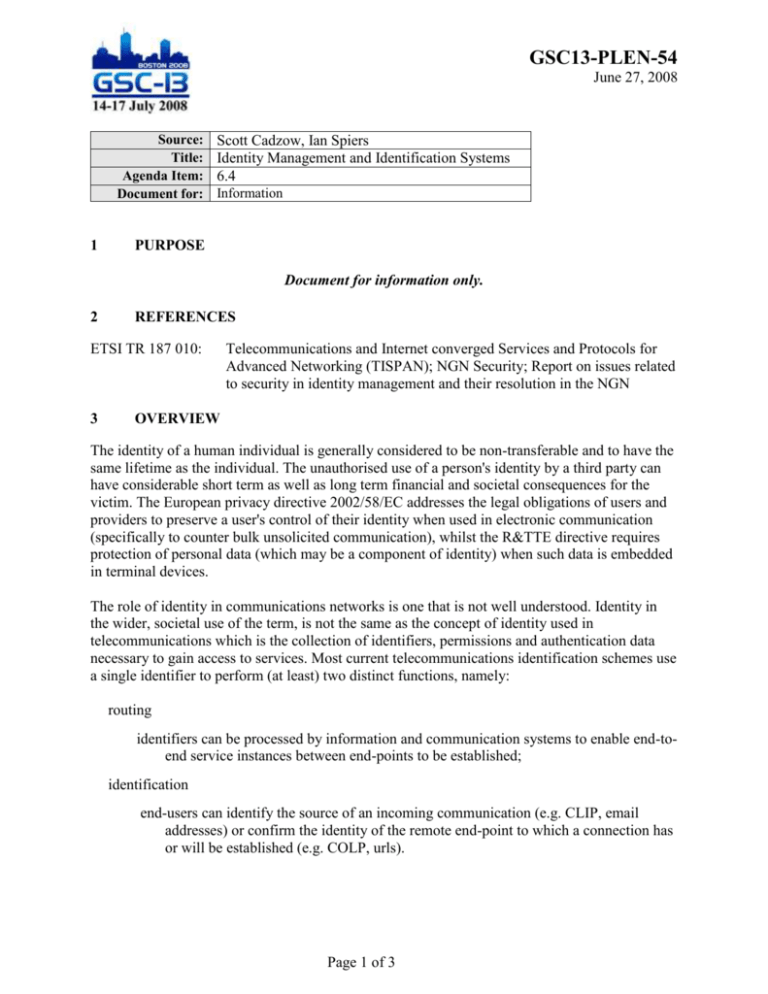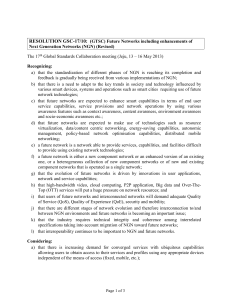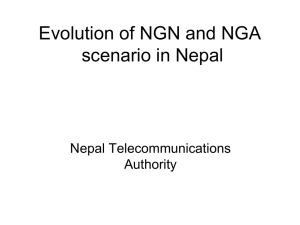Identity Management and Identification Systems
advertisement

GSC13-PLEN-54 June 27, 2008 Source: Title: Agenda Item: Document for: 1 Scott Cadzow, Ian Spiers Identity Management and Identification Systems 6.4 Information PURPOSE Document for information only. 2 REFERENCES ETSI TR 187 010: 3 Telecommunications and Internet converged Services and Protocols for Advanced Networking (TISPAN); NGN Security; Report on issues related to security in identity management and their resolution in the NGN OVERVIEW The identity of a human individual is generally considered to be non-transferable and to have the same lifetime as the individual. The unauthorised use of a person's identity by a third party can have considerable short term as well as long term financial and societal consequences for the victim. The European privacy directive 2002/58/EC addresses the legal obligations of users and providers to preserve a user's control of their identity when used in electronic communication (specifically to counter bulk unsolicited communication), whilst the R&TTE directive requires protection of personal data (which may be a component of identity) when such data is embedded in terminal devices. The role of identity in communications networks is one that is not well understood. Identity in the wider, societal use of the term, is not the same as the concept of identity used in telecommunications which is the collection of identifiers, permissions and authentication data necessary to gain access to services. Most current telecommunications identification schemes use a single identifier to perform (at least) two distinct functions, namely: routing identifiers can be processed by information and communication systems to enable end-toend service instances between end-points to be established; identification end-users can identify the source of an incoming communication (e.g. CLIP, email addresses) or confirm the identity of the remote end-point to which a connection has or will be established (e.g. COLP, urls). Page 1 of 3 GSC13-PLEN-54 June 27, 2008 Failure of the first of these two functions may result in loss of service to end-users. To ensure that such failures do not occur, rules relating to the content and formatting of communication identifiers are enforced. As a result, most communications related identifiers have a defined structure which simplifies the identification of region, domain and/or end-point. In many cases of attack on identity, countermeasures already exist, using corroborating data to reinforce the observation of an assertion of identity. Many organisations do not rely on a single identifier as an assertion of identity. Consequently, when trying to masquerade as a legitimate user, a criminal will seek to recover multiple correlated forms of identification and use them in combination to counter the identity checks. In those contexts where identity is represented by an identifier having a known structure (as is the case in email names and the E.164 numbering schemes) it is possible for the identity to be falsely claimed. Identity management is an important aspect in overcoming current concerns regarding the definition of exactly what constitutes a user and what rights that user has. Unfortunately, as identity is a rather abstract concept, its management is difficult to define and specify. 4 PURPOSE OF IDENTITY AND IDENTITY MANAGEMENT IN THE NGN Strictly speaking identity is not used in the course of signalling in the NGN, rather only identifiers for objects are used. The association of objects to individuals may allow an identity to be revealed although in most cases such traffic analysis and the building of associations is not an NGN trait. An identity (strictly identifier) is used within the NGN to distinguish one NGN entity from another. The NGN entity may be an end-point (e.g. a telephone) or it may be service delivery agent (e.g. a service provider). The purpose of Identity Management in the NGN is to control the life of an NGN identifier from its creation through assignment and, if necessary, reassignment, to its destruction at the end of its useful life. Identity Management may also include the maintenance of the integrity of an identifier. NOTE: It is assumed that an NGN identifier is a machine processable token used to name an entity. TS 184 002 defines 3 classes of identifier which are not mutually exclusive: 1. Those generated automatically by network elements (e.g. call identifiers); 2. Those that may be allocated by operators without reference to external bodies (e.g. customer account number); 3. Those that are allocated to operators by external bodies (e.g. E.164 numbers, public IP addresses). As only the identifiers in classes 2 and 3 are directly related to the end-user, it is these that may have value if stolen (see also the CRAVED analysis in table Error! Reference source not found.). Page 2 of 3 GSC13-PLEN-54 June 27, 2008 5 SUMMARY Summary of TISPAN, NGN development in NGN ETSI has taken great care to try and distinguish identity from identifier and in the course of analysis has identified that in an NGN the management of identity is not in scope, or in the range of capability of an NGN operator. However the management of identifiers is essential to the success of the NGN, and the control of association of identifiers to persons that may reveal identity is subject to control and will be addressed in the work programme of ETSI TISPAN in late 2008. Page 3 of 3











